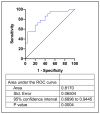Circulating miR-451a Expression May Predict Recurrence in Atrial Fibrillation Patients after Catheter Pulmonary Vein Ablation
- PMID: 36831306
- PMCID: PMC9953933
- DOI: 10.3390/cells12040638
Circulating miR-451a Expression May Predict Recurrence in Atrial Fibrillation Patients after Catheter Pulmonary Vein Ablation
Abstract
Atrial fibrillation is the most prevalent tachyarrhythmia in clinical practice, with very high cardiovascular morbidity and mortality with a high-cost impact in health systems. Currently, it is one of the main causes of stroke and subsequent heart failure and sudden death. miRNAs mediate in several processes involved in cardiovascular disease, including fibrosis and electrical and structural remodeling. Several studies suggest a key role of miRNAs in the course and maintenance of atrial fibrillation. In our study, we aimed to identify the differential expression of circulating miRNAs and their predictive value as biomarkers of recurrence in atrial fibrillation patients undergoing catheter pulmonary vein ablation. To this effect, 42 atrial fibrillation patients were recruited for catheter ablation. We measured the expression of 84 miRNAs in non-recurrent and recurrent groups (45.2%), both in plasma from peripheral and left atrium blood. Expression analysis showed that miRNA-451a is downregulated in recurrent patients. Receiver operating characteristic curve analysis showed that miR-451a in left atrium plasma could predict atrial fibrillation recurrence after pulmonary vein isolation. In addition, atrial fibrillation recurrence is positively associated with the increment of scar percentage. Our data suggest that miRNA-451a expression plays an important role in AF recurrence by controlling fibrosis and progression.
Keywords: atrial fibrillation; biomarker; miR-451a; microRNAs; recurrence; scar percentage.
Conflict of interest statement
The authors declare no conflict of interest.
Figures





Similar articles
-
Relationship between atrial scar on cardiac magnetic resonance and pulmonary vein reconnection after catheter ablation for paroxysmal atrial fibrillation.J Cardiovasc Electrophysiol. 2019 May;30(5):727-740. doi: 10.1111/jce.13908. Epub 2019 Mar 25. J Cardiovasc Electrophysiol. 2019. PMID: 30847990
-
MRI Assessment of Ablation-Induced Scarring in Atrial Fibrillation: Analysis from the DECAAF Study.J Cardiovasc Electrophysiol. 2015 May;26(5):473-80. doi: 10.1111/jce.12650. Epub 2015 Apr 23. J Cardiovasc Electrophysiol. 2015. PMID: 25727106
-
Effect of substrate modification in catheter ablation of paroxysmal atrial fibrillation: pulmonary vein isolation alone or with complex fractionated electrogram ablation.Tex Heart Inst J. 2012;39(3):372-9. Tex Heart Inst J. 2012. PMID: 22719147 Free PMC article.
-
Recurrent Atrial Fibrillation After Cryoballoon Ablation: What to Expect!Card Electrophysiol Clin. 2020 Jun;12(2):199-208. doi: 10.1016/j.ccep.2020.02.002. Card Electrophysiol Clin. 2020. PMID: 32451104 Review.
-
Catheter Ablation of Paroxysmal Atrial Fibrillation: Have We Achieved Cure with Pulmonary Vein Isolation?Methodist Debakey Cardiovasc J. 2015 Apr-Jun;11(2):71-5. doi: 10.14797/mdcj-11-2-71. Methodist Debakey Cardiovasc J. 2015. PMID: 26306122 Free PMC article. Review.
Cited by
-
MicroRNAs as Prognostic Biomarkers for Atrial Fibrillation Recurrence After Catheter Ablation: Current Evidence and Future Directions.Biomedicines. 2024 Dec 26;13(1):32. doi: 10.3390/biomedicines13010032. Biomedicines. 2024. PMID: 39857616 Free PMC article. Review.
-
Research progress of non-coding RNA in atrial fibrillation.Front Cardiovasc Med. 2023 Jul 14;10:1210762. doi: 10.3389/fcvm.2023.1210762. eCollection 2023. Front Cardiovasc Med. 2023. PMID: 37522088 Free PMC article. Review.
-
Plasma miR-486-5p Expression Is Upregulated in Atrial Fibrillation Patients with Broader Low-Voltage Areas.Int J Mol Sci. 2023 Oct 17;24(20):15248. doi: 10.3390/ijms242015248. Int J Mol Sci. 2023. PMID: 37894937 Free PMC article.
-
miR-1-3p Downregulation as a Consistent Biomarker for Atrial Fibrillation Burden in Patients with Sick Sinus Syndrome: A Multi-Sample Analysis.Int J Mol Sci. 2025 May 21;26(10):4936. doi: 10.3390/ijms26104936. Int J Mol Sci. 2025. PMID: 40430077 Free PMC article.
-
Factors predicting the recurrence of atrial fibrillation after catheter ablation: A review.Heliyon. 2024 Jul 6;10(13):e34205. doi: 10.1016/j.heliyon.2024.e34205. eCollection 2024 Jul 15. Heliyon. 2024. PMID: 39071658 Free PMC article. Review.
References
-
- Go A.S., Hylek E.M., Phillips K.A., Chang Y., Henault L.E., Selby J.V., Singer D.E. Prevalence of Diagnosed Atrial Fibrillation in Adults: National Implications for Rhythm Management and Stroke Prevention: The AnTicoagulation and Risk Factors in Atrial Fibrillation (ATRIA) Study. JAMA. 2001;285:2370–2375. doi: 10.1001/jama.285.18.2370. - DOI - PubMed
Publication types
MeSH terms
Substances
LinkOut - more resources
Full Text Sources
Medical

